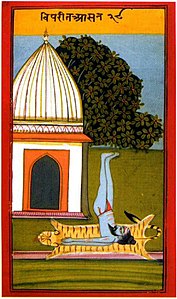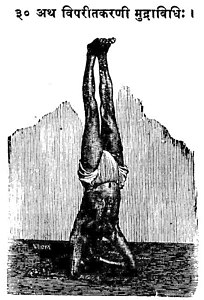
Viparita Karani

Viparita Karani (Sanskrit: विपरीतकरणी; IAST: viparītakaraṇī) or legs up the wall pose is both an asana and a mudra in hatha yoga. In modern yoga as exercise, it is commonly a fully supported pose using a wall and sometimes a pile of blankets, where it is considered a restful practice. As a mudra it was practised using any preferred inversion, such as a headstand or shoulderstand. The purpose of the mudra was to reverse the downward flow of vital fluid being lost from the head, using gravity.
Etymology and origins
The name comes from the Sanskrit words विपरीत viparīta, "inverted" or "reversed", and करणी karaṇī, "a particular type of practice".
The practice is described in the 13th century Vivekamārtaṇḍa (verses 103-131) as a means of yogic withdrawal, pratyahara.
The pose was practised from the 17th century onwards in hatha yoga under names such as Narakasana, Kapalasana and Viparitakaranasana; its purpose as a mudra was to reverse the downflow and loss of the life-giving substance (Bindu) through the use of gravity. In the early Bindu Model of Hatha Yoga, as described in the Hatha Yoga Pradipika and other texts, the vital fluid is held in the head but constantly drips down and is lost. Mudras were thought to block the central sushumna nadi channel of the subtle body and work to force the flow back up, or in the case of Viparita Karani actually reverse the flow, using gravity. A headstand is described and illustrated in halftone as Viparita Karani in the 1905 Yogasopana Purvacatuska.
Early Bindu Model of Hatha Yoga, as described in the Hatha Yoga Pradipika and other texts. Mudras such as Viparita Karani can reverse the flow, stopping the loss of vital fluid.
Viparita Karani using a shoulderstand from an illustrated manuscript of the Joga Pradipika, 1830
Viparita Karani using a headstand in Yogasopana Purvacatuska, 1905
Description
Viparita Karani can be any practice where one is upside down. This can include the asanas of shoulder stand (Sarvangasana), headstand (Sirsasana), or handstand (Adho Mukha Vrksasana). In the Hatha Yoga Pradipika, as in most classical texts on haṭha yoga, Viparita Karani is listed as a mudra, meaning its purpose is for the directing of energy upwards within the body, using gravity's action on the inverted body, as opposed to asanas which are used in the Hatha Yoga Pradipika to create steadiness.
In one popular expression of Viparita Karani as an asana in modern postural yoga, it resembles Salamba Sarvāngāsana (supported shoulder stand) but with extension in the thoracic spine (rather than the cervical spine, elbows on the floor and hands supporting hips or lower back.
Variations
In Iyengar Yoga, the pose, also called "Legs-up-the-Wall Pose", is described as "a restful practice, where the body is inverted without effort", and the lower back and buttocks are supported with a pile of blankets, while the legs are rested against a wall, either together or allowed to fall outwards into a straddle.
In Uttanapadasana, meaning "feet up pose", the back rests on the floor and the legs point straight up, either against a wall, supported with a strap, or free.
In Urdhva Prasarita Padasana, the back is on the ground, the arms are stretched out on the floor above the head, and the legs are raised either partly or to the vertical.
In pregnancy, the pose can be practised as "Wall Butterfly", with the buttocks and feet against a wall, feet together as in Baddha Konasana, the knees falling to the sides. The hands can be used to press the knees.
Sources
- Mallinson, James; Singleton, Mark (2017). Roots of Yoga. Penguin Books. ISBN 978-0-241-25304-5. OCLC 928480104.
- Mehta, Silva; Mehta, Mira; Mehta, Shyam (1990). Yoga: The Iyengar Way. Dorling Kindersley.
| Topics |
|
|||||||||||||
|---|---|---|---|---|---|---|---|---|---|---|---|---|---|---|
| History |
|
|||||||||||||
|
Schools (Gurus) |
|
|||||||||||||
| Related | ||||||||||||||
| Subtle body | ||
|---|---|---|
| Texts (Asanas) |
|
|
| Mudras | ||
| Shatkarmas | ||
| Pranayama | ||
| Related | ||
![Early Bindu Model of Hatha Yoga, as described in the Hatha Yoga Pradipika and other texts. Mudras such as Viparita Karani can reverse the flow, stopping the loss of vital fluid.[4]](http://upload.wikimedia.org/wikipedia/commons/thumb/1/16/Early_Bindu_Model_of_Hatha_Yoga.svg/316px-Early_Bindu_Model_of_Hatha_Yoga.svg.png)





